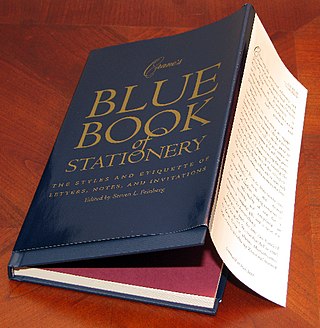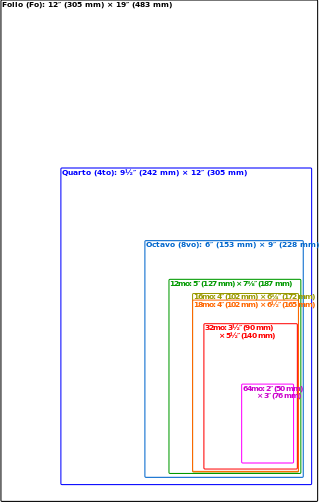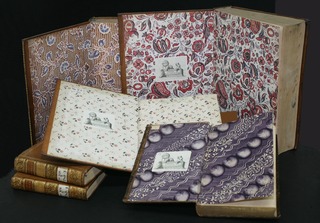
A book is a medium for recording information in the form of writing or images, typically composed of many pages bound together and protected by a cover. It can also be a handwritten or printed work of fiction or nonfiction, usually on sheets of paper fastened or bound together within covers. The technical term for this physical arrangement is codex. In the history of hand-held physical supports for extended written compositions or records, the codex replaces its predecessor, the scroll. A single sheet in a codex is a leaf and each side of a leaf is a page.

The codex was the historical ancestor of the modern book. Instead of being composed of sheets of paper, it used sheets of vellum, papyrus, or other materials. The term codex is often used for ancient manuscript books, with handwritten contents. A codex, much like the modern book, is bound by stacking the pages and securing one set of edges by a variety of methods over the centuries, yet in a form analogous to modern bookbinding. Modern books are divided into paperback and those bound with stiff boards, called hardbacks. Elaborate historical bindings are called treasure bindings. At least in the Western world, the main alternative to the paged codex format for a long document was the continuous scroll, which was the dominant form of document in the ancient world. Some codices are continuously folded like a concertina, in particular the Maya codices and Aztec codices, which are actually long sheets of paper or animal skin folded into pages.

A manuscript was, traditionally, any document written by hand or typewritten, as opposed to mechanically printed or reproduced in some indirect or automated way. More recently, the term has come to be understood to further include any written, typed, or word-processed copy of an author's work, as distinguished from the rendition as a printed version of the same.

The dust jacket of a book is the detachable outer cover, usually made of paper and printed with text and illustrations. This outer cover has folded flaps that hold it to the front and back book covers.

Woodblock printing or block printing is a technique for printing text, images or patterns used widely throughout East Asia and originating in China in antiquity as a method of printing on textiles and later paper. Each page or image is created by carving a wooden block to leave only some areas and lines at the original level; it is these that are inked and show in the print, in a relief printing process. Carving the blocks is skilled and laborious work, but a large number of impressions can then be printed.

A treasure binding or jewelled bookbinding is a luxurious book cover using metalwork in gold or silver, jewels, or ivory, perhaps in addition to more usual bookbinding material for book-covers such as leather, velvet, or other cloth. The actual bookbinding technique is the same as for other medieval books, with the folios, normally of vellum, stitched together and bound to wooden cover boards. The metal furnishings of the treasure binding are then fixed, normally by tacks, onto these boards. Treasure bindings appear to have existed from at least Late Antiquity, though there are no surviving examples from so early, and Early Medieval examples are very rare. They were less used by the end of the Middle Ages, but a few continued to be produced in the West even up to the present day, and many more in areas where Eastern Orthodoxy predominated. The bindings were mainly used on grand illuminated manuscripts, especially gospel books designed for the altar and use in church services, rather than study in the library.

The size of a book is generally measured by the height against the width of a leaf, or sometimes the height and width of its cover. A series of terms is commonly used by libraries and publishers for the general sizes of modern books, ranging from folio, to quarto (smaller) and octavo. Historically, these terms referred to the format of the book, a technical term used by printers and bibliographers to indicate the size of a leaf in terms of the size of the original sheet. For example, a quarto historically was a book printed on sheets of paper folded in half twice, with the first fold at right angles to the second, to produce 4 leaves, each leaf one fourth the size of the original sheet printed – note that a leaf refers to the single piece of paper, whereas a page is one side of a leaf. Because the actual format of many modern books cannot be determined from examination of the books, bibliographers may not use these terms in scholarly descriptions.

Wasōbon is a traditional book style in Japan that dates from the late eighth century AD with the printing of "Hyakumantō Darani" during the reign of Empress Shōtoku (764-770AD). The majority of books were hand-copied until the Edo period (1603–1867), when woodblock printing became comparatively affordable and widespread. Movable-type printing had been used from the late 16th century, but for various aesthetic and practical reasons woodblock printing and hand-copied remained dominant until much later. Japanese equivalents for "book" include 本 (hon) and 書籍 (shoseki). The former term indicates only bound books, and does not include scrolls. The latter is used for printed matter only. The most general term is 書物 (shomotsu), which means all written or printed matter that has been collected into a single unit, regardless of construction.

Bindery refers to a studio, workshop or factory where sheets of (usually) paper are fastened together to make books, but also where gold and other decorative elements are added to the exterior of books, where boxes or slipcases for books are made and where the restoration of books is carried out.

The endpapers or end-papers of a book are the pages that consist of a double-size sheet folded, with one half pasted against an inside cover, and the other serving as the first free page. Thus, the front endpapers precede the title page and the text, whereas the back endpapers follow the text. Booksellers sometimes refer to the front endpaper as FEP.

Coptic binding or Coptic sewing comprises methods of bookbinding employed by early Christians in Egypt, the Copts, and used from as early as the 2nd century AD to the 11th century. The term is also used to describe modern bindings sewn in the same style.
The conservation and restoration of illuminated manuscripts is the care and treatment of illuminated manuscripts which have cultural and historical significance so that they may be viewed, read, and studied now and in the future. It is a specialty case of the conservation and restoration of parchment within the field of conservation and restoration of books, manuscripts, documents and ephemera.

Quarto is the format of a book or pamphlet produced from full sheets printed with eight pages of text, four to a side, then folded twice to produce four leaves. The leaves are then trimmed along the folds to produce eight book pages. Each printed page presents as one-fourth size of the full sheet.

The term "folio", has three interconnected but distinct meanings in the world of books and printing: first, it is a term for a common method of arranging sheets of paper into book form, folding the sheet only once, and a term for a book made in this way; second, it is a general term for a sheet, leaf or page in (especially) manuscripts and old books; and third, it is an approximate term for the size of a book, and for a book of this size.

An intentionally blank page or vacat page is a page that has no content and may be unexpected. Such pages may serve purposes ranging from place-holding to space-filling and content separation. Sometimes, these pages carry a notice such as "This page intentionally left blank." Such notices typically appear in printed works, such as legal documents, manuals, and exam papers, in which the reader might otherwise suspect that the blank pages are due to a printing error and where missing pages might have serious consequences.

Bookbinding is the process of building a book of codex manuscripts from an ordered stack of paper sheets with one's hands and tools. Firstly, one binds the sheets of papers along an edge with a thick needle and strong thread. One can also use loose-leaf rings, binding posts, twin-loop spine coils, plastic spiral coils, and plastic spine combs, but they last for a shorter time. Next, one encloses the bound stack of paper in a cover. Finally, one places an attractive cover onto the boards, and features the publisher's information and artistic decorations.

The 36-line Bible, also known as the "Bamberg Bible", was the second moveable-type-printed edition of the Bible. It is believed to have been printed in Bamberg, Germany, circa 1458–1460. No printer's name appears in the book, but it is possible that Johannes Gutenberg was the printer.
Disjecta membra, also written disiecta membra, is Latin for "scattered fragments" and is used to refer to surviving fragments of ancient poetry, manuscripts, and other literary or cultural objects, including even fragments of ancient pottery. It is derived from disiecti membra poetae, a phrase used by Horace, a Roman poet.
The Sandars Readership in Bibliography is an annual lecture series given at Cambridge University. Instituted in 1895 at the behest of Mr Samuel Sandars of Trinity College (1837–1894), who left a £2000 bequest to the University, the series has continued down to the present day. Together with the Panizzi Lectures at the British Library and the Lyell Lectures at Oxford University, it is considered one of the major British bibliographical lecture series.

Fragmentology is the study of surviving fragments of manuscripts. A manuscript fragment may consist of whole or partial leaves, typically made of parchment, conjugate pairs or sometimes gatherings of a parchment book or codex, or parts of single-leaf documents such as notarial acts. They are commonly found in book bindings, especially printed books from the 15th to the 17th centuries, used in a variety of ways such as wrappers or covers for the book, as endpapers, or cut into pieces and used to reinforce the binding. In other non-Western manuscript cultures, fragments of paper manuscripts and other materials, takes place beside parchment, including board covers that many times reused written paper.


















